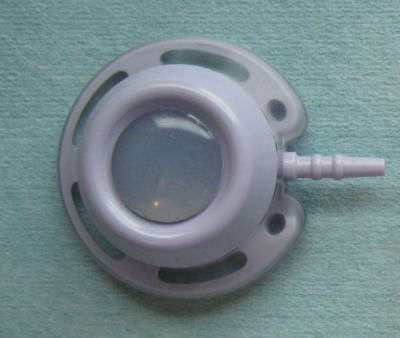Categorised under:
Interventional Radiology
>
Vascular
>
Venous ports
Subcutaneous venous ports are rapidly becoming the method of choice for venous access for patients requiring long term intravenous therapy. Within the last two years there have been several power injectable ports launched that allow the high flow rates used in modern multislice CT. Ian McCafferty has recently reviewed the Bard PowerPort. I have experience of inserting both the PowerPort and the Medcomp Pro Fuse CT Port.
Subcutaneous venous ports are rapidly becoming the method of choice for venous access for patients requiring long term intravenous therapy. Within the last two years there have been several power injectable ports launched that allow the high flow rates used in modern multislice CT. Ian McCafferty has recently reviewed the Bard PowerPort. I have experience of inserting both the PowerPort and the Medcomp Pro Fuse CT Port.
The Pro Fuse port is made completely of plastic making it both MRI and CT compatible. Like the PowerPort it allows injection rates of up to 5ml/sec at a pressure of up to 300psi.

The port is moulded from plastic with a raised edge around the septum. This is similar to the PowerPort in that it allows identification of the type of port. The Pro Fuse has in addition the letters CT imprinted on the under surface of the port which can be seen on x-ray for identification. Like the 3 small bumps on the PowerPort, the raised rim may well not be readily palpable if the port is placed in a deep pocket and these features should not be relied upon for identification. The patients are given a bracelet and also a key ring as reminders of the type of port they have inserted.
The port is inserted in the standard fashion (see training video) and should provide no problems for any experienced interventionist. Medcomp have a huge amount of experience with venous access and the kit comes with all the equipment needed for insertion. A nice touch is the guide-wire holder that has a moulded plastic ‘slot’ so that you can advance the wire with your thumb into the needle. (I always find it irritating when your assistant passes you the wire in such a way that you can’t easily take it to advance straight into the needle). The catheter is also packed in the kit so that it is not tightly coiled. This is a criticism of the Bard PowerPort as some say the coiling in the packet leads the tip of the catheter to lie against the vessel/atrial wall. I have only found this to be a problem on one occasion.
The Pro Fuse comes in two versions. One with the line attached and one without.
I had one problem on my first use of this port when I was pushing the line onto the port connector and I managed to kink it by not pushing it on straight. Providing you are aware of this it should not be a problem.
The peelaway sheath is valved.
Pros: Cost, plastic, light weight
Cons: Slightly larger, be careful pushing the line onto the port
Overall, another good port from a well known manufacturer. I would like to see it in a lower profile version. If Medcomp can do this and maintain a decent price then they will be on to a winner. There are several other power injectable ports now coming to market so the competition should keep prices lower and make them financially a very attractive alternative to a Hickman type line.
Dr Phil Haslam
Consltant Interventional Radiologist
Freeman Hospital
Newcastle upon Tyne, UK
No Conflict

Did you know you can Register for FREE with this website?
Registration gives you full access to all of the features of WhichMedicalDevice. Find out more ...
WhichMedicalDevice is a FREE resource created by clinicians for clinicians.
Registration is free and gives you unlimited access to all of the content and features of this website.
Find out more...Registration is free and gives you unlimited access to all of the content and features of Which Medical Device. Find out more...
Which Medical Device is a community of clinicians sharing knowledge and experience of the devices and procedures we use on a daily basis. We ask that our members register with us so that we can maintain the unbiased and independent nature of our content. Registration is quick and free.
We do not make your details available to any third parties nor do we send unsolicited emails to our members. You can read our Privacy Policy here.